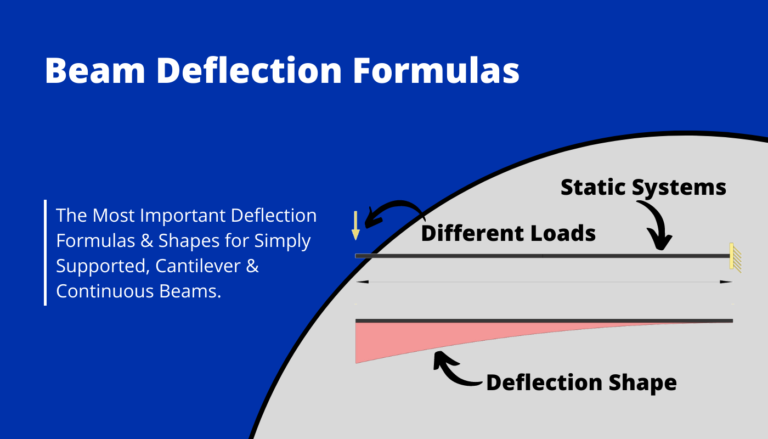Flat Truss: What Is It? And How To Calculate It?
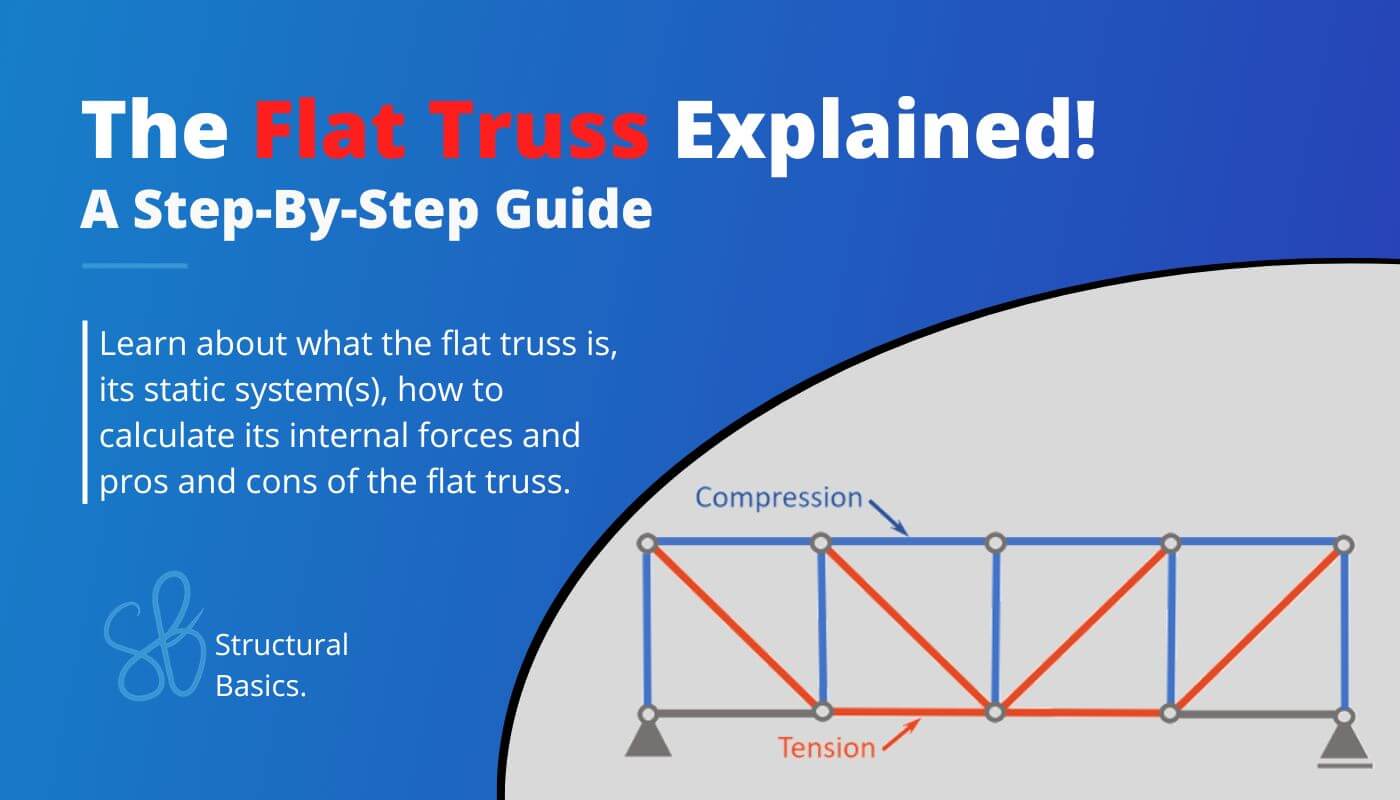
Are you wondering how to calculate and design a flat truss? 🤔🤔
It can indeed be difficult, if you didn’t study structural engineering.
But in this blog post, we’ll try to explain the flat truss as simple as possible for everyone.👍👍
We’ll explain their key features, benefits, common uses and go through a calculation example, step-by-step.
Alright, let’s talk FLAT TRUSSES. 🚀🚀
What Is A Flat Truss?
The flat truss is a structural system commonly used in engineering projects like bridge and building structures. It’s characterized by a series of triangles that support the loads of a structure (wind, snow, dead, live load).
Let’s have a look at a visualization of the flat truss and its members.⬇️⬇️
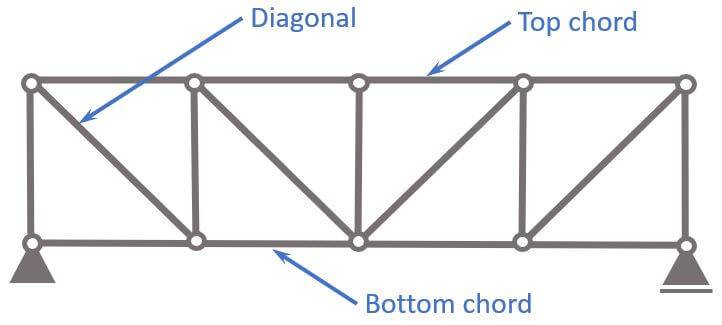
- Top Chord
- Bottom Chord
- Diagonals
What is the flat truss used for?
Flat trusses are used as bridge structures but also for long spans as “beams” in buildings.
In most cases, steel is the main material, however timber could also be an option.
Let’s look at the static system to get a better understanding of the structural behaviour of the flat truss.🚀🚀
Static System
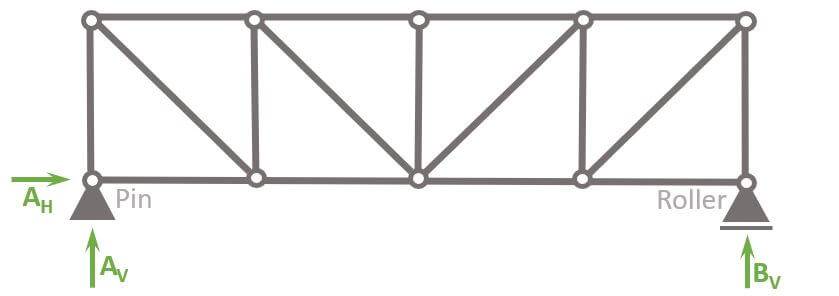
The static system of the flat truss is characterized by having
- hinge connections at all nodes
- a pin and roller support, which makes the system statically determinate. Therefore, the internal forces can be calculated with the 3 equilibrium equations.
💡💡 The flat truss can also include more triangles and members. The picture above is just one of many examples of a flat truss.
Hinges
Most truss structures are designed with hinge connections, mainly due to 2 reasons:
- Easier to calculate: Trusses with hinge connections make the structure statically determinate, which means that the internal forces can be calculated by hand. Especially until advanced Finite element software programs weren’t widely available, this was the main reason for using hinge connections. If fixed connections are used, but no software is available, advanced methods like the method of consistent deformation can be used. However, these methods are complicated and susceptible to calculation failures.
- Cost: Hinge connections are cheaper to build than fixed connections.
It definitely makes sense to be aware of the differences of a truss with hinges and fixed connections. In the picture above, you can see the “normal” flat truss with hinge connections.
We also summarize the characteristics of the truss with fixed connections and a mix of fixed and hinge connections a bit further below.
Characteristics
Loads
If the flat truss is used as a bridge structure, then dead and traffic loads are applied on the bottom chord. In buildings, the flat roof is used to support floors. In that case, dead and live load act on the top chord.
Support types
1 Pin and 1 Roller support
Reactions
Pin support: Horizontal AH and vertical reaction force AV
Roller support: Vertical reaction force BV
Connection types
Hinge connections: Moment is 0 in hinge connections.
Flat truss with fixed connections
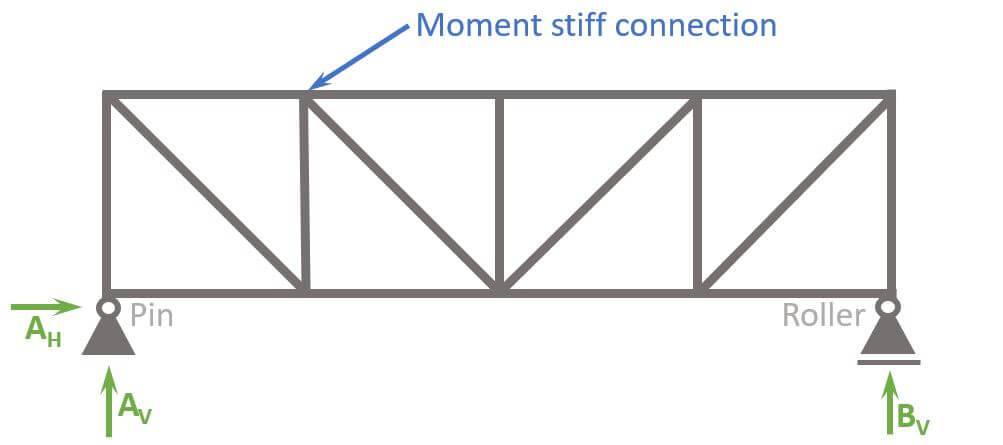
The flat truss with fixed connections has the following differences to hinge connections:
- Bending moments in the connections
- More rigidity -> more robustness
- Smaller vertical deflection
Flat truss with fixed and hinge connections
The most realistic static system might actually be a mix of fixed and hinge connections.
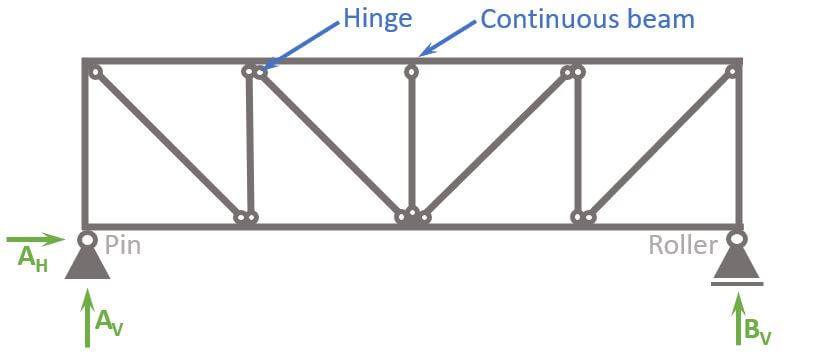
So why is this the most realistic static system?
It’s because the top and bottom chord might be delivered in 1 piece, meaning that they are constructed continuous and the posts and diagonals are attached to them.
If the span is too long to deliver them in one piece, then moment stiff connections are design in areas where the moment is close to 0. This is cheaper and more sustainable.
The top chord basically turns into a 4-span continuous beam, which means that the static system is no longer statically determinate.
This means that advanced methods with FE programs need to be used to calculate the internal forces like Moment, Normal and Shear forces.
Alright, now that we have learned how to set up our static system, we are ready to calculate the internal compression and tension forces of the statically determinate truss.🎉🎉
Flat Truss Analysis
Let’s say our flat truss is supporting a floor in a building. Therefore, the truss is exposed to the dead and live load of the floor above on the top chord.
We also simplify and say that the design load (Load combination of dead and live load) is 30 kN/m.
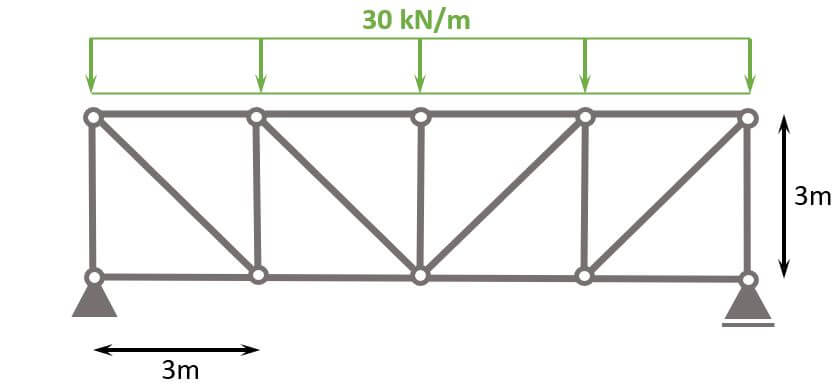
Before we start with the calculations, let’s give the nodes 🔵 and bars 🔴 some indices, so the identification is easier later in the internal force calculation.
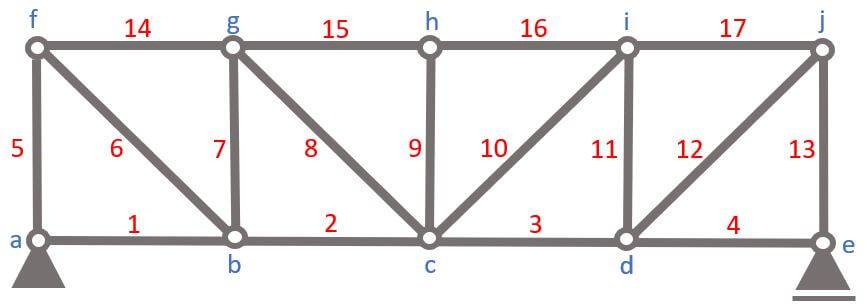
To calculate the compression and tension forces of the truss members with the 3 equlibrium equations, we do another approximation.
The line load of 30 kN/m is approximated as point loads in the nodes, because otherwise the top chord members would be beams, which makes the calculation a lot more difficult.
The point load applied to nodes (f) and (j) is calculated as
$$30 kN/m \cdot 1.5m = 45 kN$$
while the point loads applied to nodes (g) – (i) are calculated as
$$30 kN/m \cdot 3m = 90 kN$$
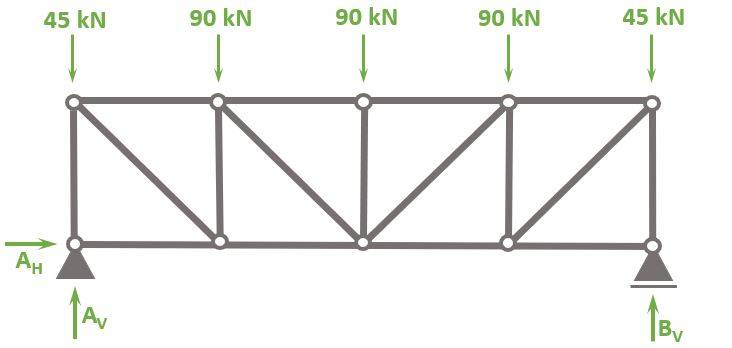
Let’s calculate. 🚀🚀
Calculation of Reaction Forces
As the structure is statically determinate, the reaction forces can be calculated with the 3 Equilibrium equations.
In our case, we are calculating the support forces AH, AV and BV.
$\sum H = 0: A_H = 0$
$\sum V = 0: A_V + B_V \, – 2 \cdot 45 \, \mbox{kN} \, – 3 \cdot 90 \, \mbox{kN} = 0 $ -> $A_V = B_V = \frac{2 \cdot 45 + 3 \cdot 90}{2} \mbox{kN} = 180 \mbox{kN}$
$\sum M = 0: M_a = 0$
Calculation of the internal forces
Node a
Alright, now that we know the reaction forces, we can calculate the normal force of the first bar elements 1 and 5.
To do that, we only look at node (a) and its point loads/normal forces AV, AH, N1 and N5.
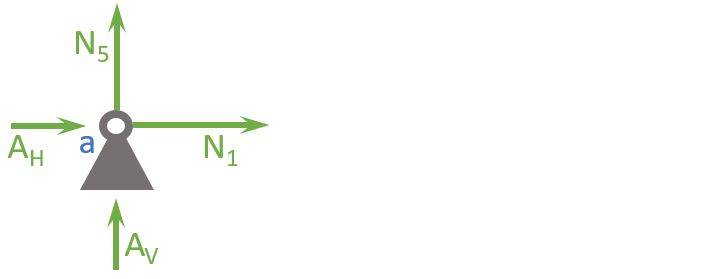
Vertical Equilibrium:
$$ \sum V = 0: A_v + N_5 = 0$$
Let’s solve that for N5.
$$ N_5 = -180 kN$$
Horizontal Equilibrium:
$$ \sum H = 0: A_H + N_1 = 0$$
Let’s solve that for N1.
$$ N_1 = A_H = 0$$
Node f
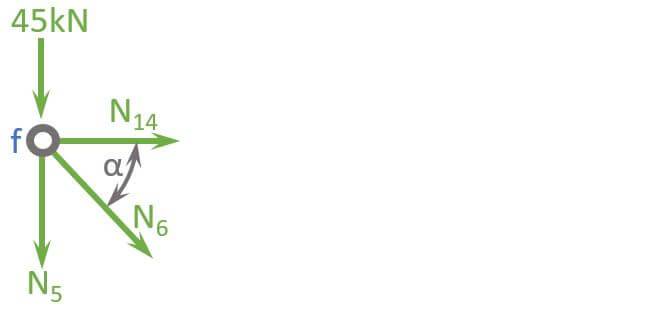
$$ \alpha = 45° $$
Vertical Equilibrium:
$$ \sum V = 0: N_{5} + 45 kN + N_6 \cdot sin(\alpha) = 0 $$
Let’s solve that for $N_6$
$$N_{6} = – \frac{N_5 + 45 kN}{sin(\alpha)} = 190.9 kN$$
Horizontal Equilibrium:
$$ \sum H = 0: N_{14} + N_6 \cos{\alpha} = 0$$
Let’s solve that for N14.
$$ N_{14} = -N_6 \cdot cos(\alpha) = -135 kN$$
Node b

Horizontal Equilibrium:
$$ \sum H = 0: N_{1} – N_2 + N_6 \cdot cos(\alpha) = 0$$
Let’s solve that for N2.
$$ N_{2} = N_{1} + N_6 \cdot cos(\alpha) = 135 kN$$
Vertical Equilibrium:
$$ \sum V = 0: N_{7} + N_6 \cdot sin(\alpha) = 0$$
Let’s solve that for N7.
$$ N_{7} = -N_6 \cdot sin(\alpha) = -135 kN$$
Node g
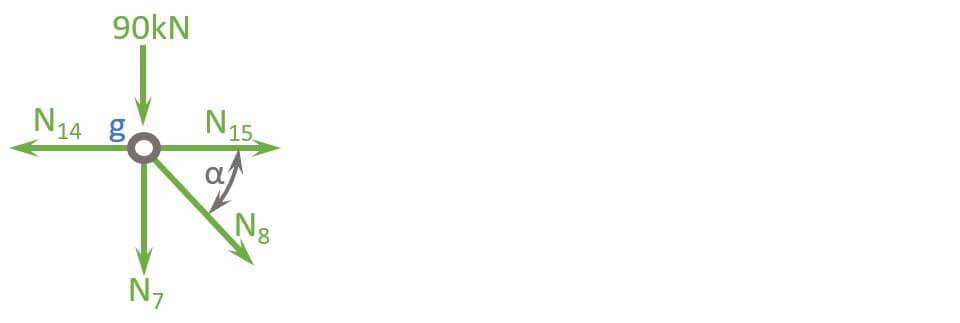
$$ \alpha = 45° $$
Vertical Equilibrium:
$$ \sum V = 0: N_{7} + 90 kN + N_{8} \cdot sin(\alpha) = 0$$
Let’s solve that for N8.
$$ N_{8} = \frac{-N_7 – 90 kN}{sin(\alpha)} = 63.6 kN$$
Horizontal Equilibrium:
$$ \sum H = 0: N_{14} – N_{15} – N_8 \cdot cos(\alpha) = 0$$
Let’s solve that for N15.
$$ N_{15} = N_{14} – N_8 \cdot cos(\alpha) = -180 kN$$
Alright, I think you understood the principle. This can be continued for nodes h and c to calculate the normal forces of the other bars.
💡💡 Due to symmetry of the truss and loads, the right half of bars has the same normal forces as their corresponding bar on the left side.
Now, a way to speed up the calculation is utilizing a FE program, which I did for this flat truss.
I used the free analysis software Ftool to do it.
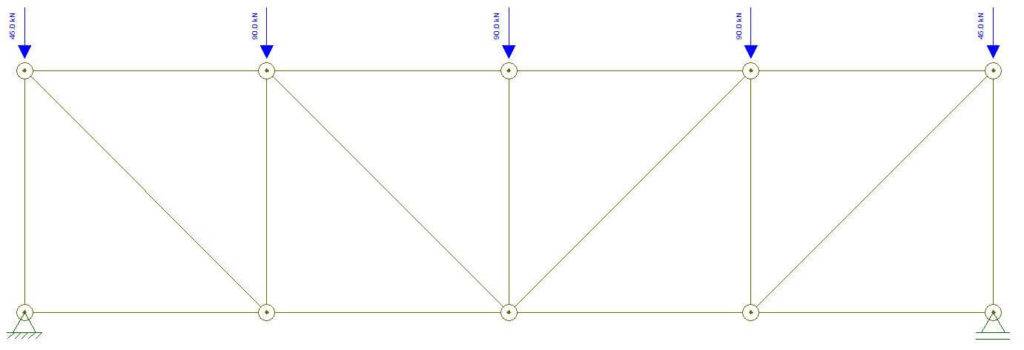
❗❗ However, I only recommend using a software if you can comfortably calculate the normal forces yourself, and you are aware of the difference of hinge and moment stiff connections, roller and pin supports. Wrong definitions in the model can lead to wrong results. So be careful here!
So, to summarize it, a normal force diagram helps to understand how the loads travel through the truss.
Normal force diagram

Compression and Tension Members
Now, as you can see in the normal force diagram, some members have a positive (+) and some have a negative (-) normal force.
A negative (-) normal force means that the member is under compression 🔵, while a positive (+) normal force means that the member acts in tension 🔴.
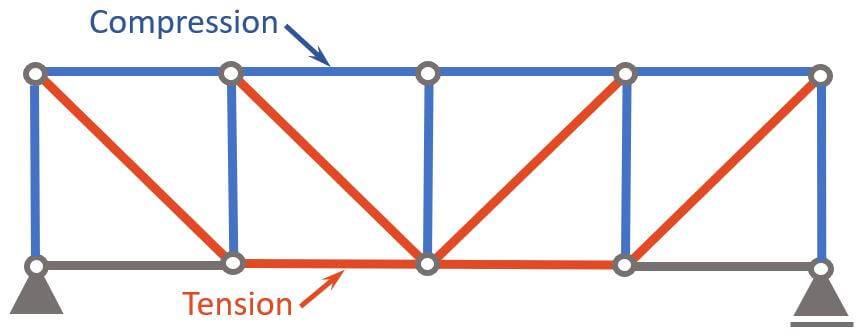
Advantages and Disadvantages
Pros
- Flexibility: Flat trusses can be designed to span a wide range of lengths and widths, making them suitable for a variety of applications, from small residential buildings to large commercial or industrial structures.
- Simplicity: Flat trusses have a simple design. The diagonals always have the same angle to the chords. This can result in lower construction costs and faster installation times compared to other trusses. This also means that there is not a big variety of different connections.
Cons
- Aesthetics: Even though I like the design of the flat truss, there are other truss structures that have a better architectural appearance, such as the scissors truss or the king post truss.
Conclusion
Now, that you got an overview of the Flat Truss, and how we calculate its internal forces, you can learn about loads, because every truss is exposed to loads.
Because there are always multiple loads acting on Flat Trusses, considering these different loads in the structural design is done by setting up Load Combinations with safety factors.🦺🦺
Once all load cases and combinations are set up, the structural elements can be designed. We have already written a guide on how to design a timber truss. Check it out!
If you want to learn more about trusses, make sure to read our guide on the different types of trusses.
I hope that this article helped you understand the Flat Truss and how to go further from here. In case you still have questions.
Let us know in the comments below. ✍️✍️
Flat Truss FAQ
A flat truss is a truss structure that has a horizontal top and bottom chord, and diagonal members that connect the chords. Flat trusses are commonly used in a variety of structures, from small residential buildings to bridge structures.
Flat trusses are commonly used in a variety of buildings, including residential, commercial, and industrial structures. They are often used in architecture to create an industrial look. Flat trusses can be designed to span a wide range of lengths, making them suitable for a variety of applications.
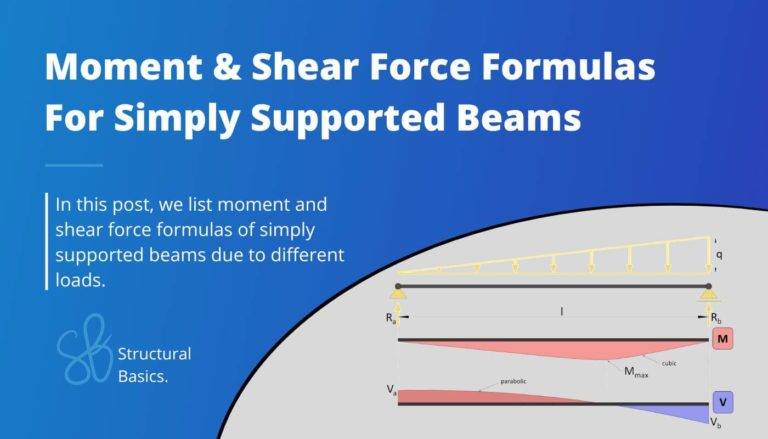
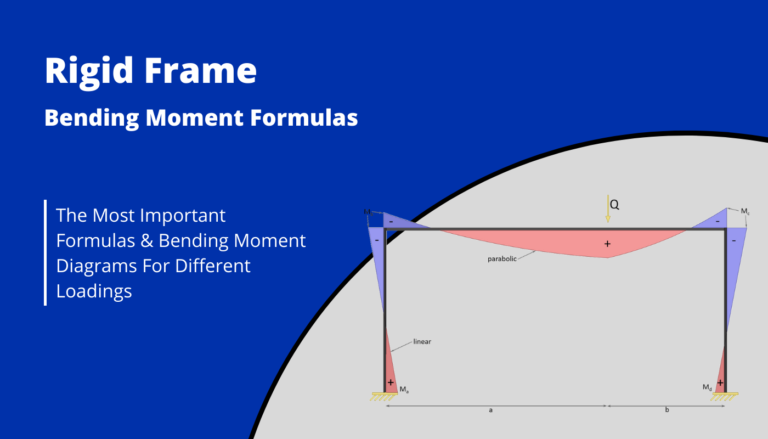
![Understand Bending Moments [Everything YOU Need To Know – 2025]](https://www.structuralbasics.com/wp-content/uploads/2023/05/Bending-moment-768x439.jpg)
![Howe Truss [A Structural Guide]](https://www.structuralbasics.com/wp-content/uploads/2022/12/Howe-truss-768x439.jpg)
![Understand Shear Forces [An Engineering Explanation]](https://www.structuralbasics.com/wp-content/uploads/2023/07/Shear-force-768x439.jpg)
